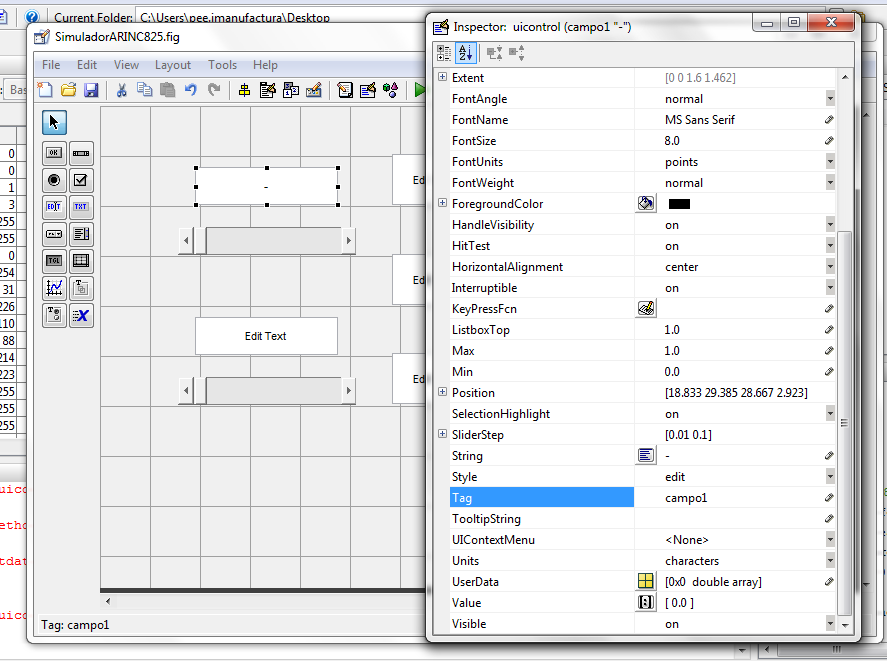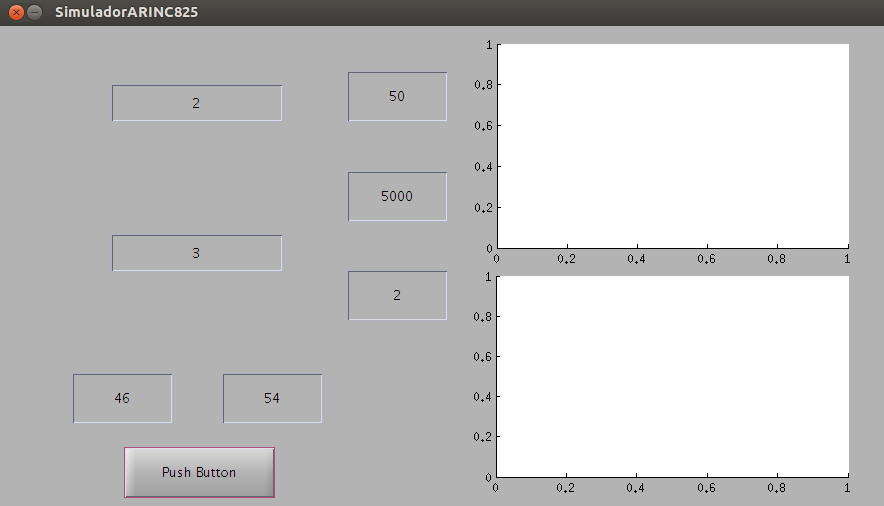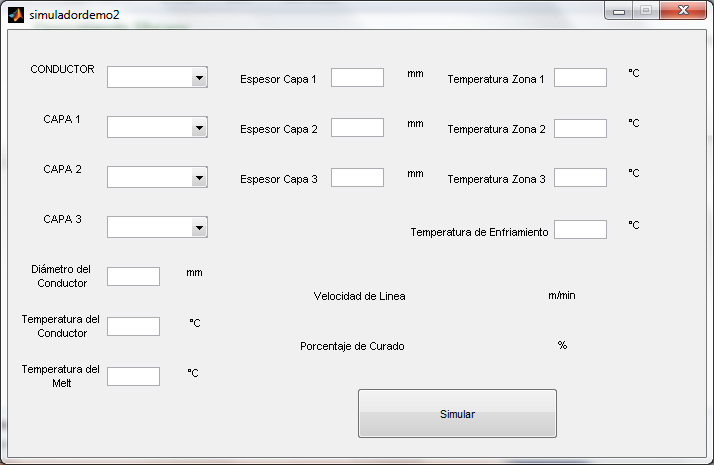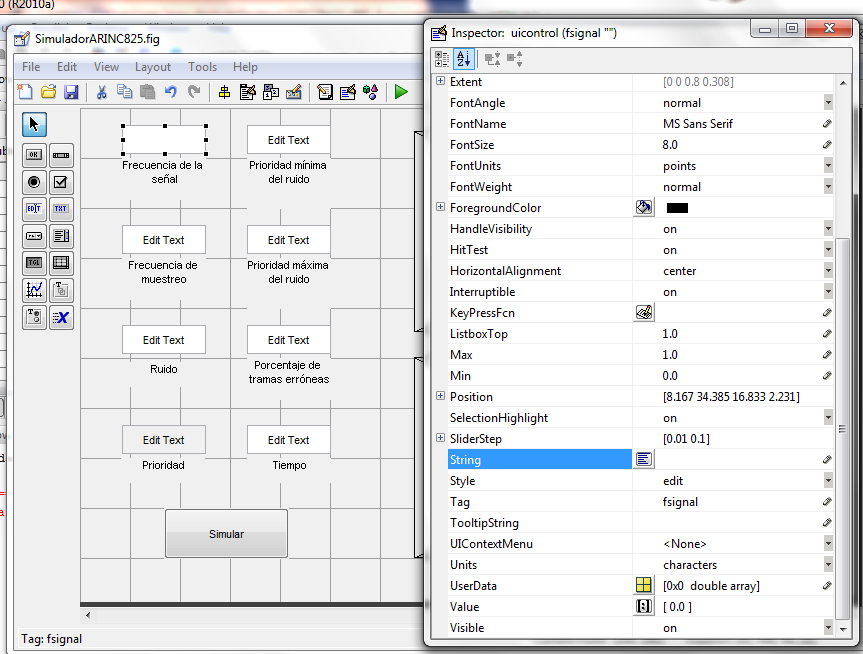function varargout = SimuladorARINC825(varargin)
%SIMULADORARINC825 M-file for SimuladorARINC825.fig
% SIMULADORARINC825, by itself, creates a new SIMULADORARINC825 or raises the existing
% singleton*.
%
% H = SIMULADORARINC825 returns the handle to a new SIMULADORARINC825 or the handle to
% the existing singleton*.
%
% SIMULADORARINC825('Property','Value',...) creates a new SIMULADORARINC825 using the
% given property value pairs. Unrecognized properties are passed via
% varargin to SimuladorARINC825_OpeningFcn. This calling syntax produces a
% warning when there is an existing singleton*.
%
% SIMULADORARINC825('CALLBACK') and SIMULADORARINC825('CALLBACK',hObject,...) call the
% local function named CALLBACK in SIMULADORARINC825.M with the given input
% arguments.
%
% *See GUI Options on GUIDE's Tools menu. Choose "GUI allows only one
% instance to run (singleton)".
%
% See also: GUIDE, GUIDATA, GUIHANDLES
% Edit the above text to modify the response to help SimuladorARINC825
% Last Modified by GUIDE v2.5 03-Jun-2014 17:56:02
% Begin initialization code - DO NOT EDIT
gui_Singleton = 1;
gui_State = struct('gui_Name', mfilename, ... 'gui_Singleton', gui_Singleton, ...
'gui_OpeningFcn', @SimuladorARINC825_OpeningFcn, ...
'gui_OutputFcn', @SimuladorARINC825_OutputFcn, ...
'gui_LayoutFcn', [], ...
'gui_Callback', []);
if nargin && ischar(varargin{1})
gui_State.gui_Callback = str2func(varargin{1});
end
if nargout
[varargout{1:nargout}] = gui_mainfcn(gui_State, varargin{:});
else
gui_mainfcn(gui_State, varargin{:});
end
% End initialization code - DO NOT EDIT
% --- Executes just before SimuladorARINC825 is made visible.
function SimuladorARINC825_OpeningFcn(hObject, eventdata, handles, varargin)
% This function has no output args, see OutputFcn.
% hObject handle to figure
% eventdata reserved - to be defined in a future version of MATLAB
% handles structure with handles and user data (see GUIDATA)
% varargin unrecognized PropertyName/PropertyValue pairs from the
% command line (see VARARGIN)
% Choose default command line output for SimuladorARINC825
handles.output = hObject;
% Update handles structure
guidata(hObject, handles);
% UIWAIT makes SimuladorARINC825 wait for user response (see UIRESUME)
% uiwait(handles.figure1);
% --- Outputs from this function are returned to the command line.
function varargout = SimuladorARINC825_OutputFcn(hObject, eventdata, handles)
% varargout cell array for returning output args (see VARARGOUT);
% hObject handle to figure
% eventdata reserved - to be defined in a future version of MATLAB
% handles structure with handles and user data (see GUIDATA)
% Get default command line output from handles structure
varargout{1} = handles.output;
function nruido_Callback(hObject, eventdata, handles)
nruido=str2double(get(hObject,'String'))
% hObject handle to nruido (see GCBO)
% eventdata reserved - to be defined in a future version of MATLAB
% handles structure with handles and user data (see GUIDATA)
% Hints: get(hObject,'String') returns contents of nruido as text
% str2double(get(hObject,'String')) returns contents of nruido as a double
% --- Executes during object creation, after setting all properties.
function nruido_CreateFcn(hObject, eventdata, handles)
% hObject handle to nruido (see GCBO)
% eventdata reserved - to be defined in a future version of MATLAB
% handles empty - handles not created until after all CreateFcns called
% Hint: edit controls usually have a white background on Windows.
% See ISPC and COMPUTER.
if ispc && isequal(get(hObject,'BackgroundColor'), get(0,'defaultUicontrolBackgroundColor'))
set(hObject,'BackgroundColor','white');
end
function notras_Callback(hObject, eventdata, handles)
notras=str2double(get(hObject,'String'))
% hObject handle to notras (see GCBO)
% eventdata reserved - to be defined in a future version of MATLAB
% handles structure with handles and user data (see GUIDATA)
% Hints: get(hObject,'String') returns contents of notras as text
% str2double(get(hObject,'String')) returns contents of notras as a double
% --- Executes during object creation, after setting all properties.
function notras_CreateFcn(hObject, eventdata, handles)
% hObject handle to notras (see GCBO)
% eventdata reserved - to be defined in a future version of MATLAB
% handles empty - handles not created until after all CreateFcns called
% Hint: edit controls usually have a white background on Windows.
% See ISPC and COMPUTER.
if ispc && isequal(get(hObject,'BackgroundColor'), get(0,'defaultUicontrolBackgroundColor'))
set(hObject,'BackgroundColor','white');
end
function fs_Callback(hObject, eventdata, handles)
fs=str2double(get(hObject,'String'))
% hObject handle to fs (see GCBO)
% eventdata reserved - to be defined in a future version of MATLAB
% handles structure with handles and user data (see GUIDATA)
% Hints: get(hObject,'String') returns contents of fs as text
% str2double(get(hObject,'String')) returns contents of fs as a double
% --- Executes during object creation, after setting all properties.
function fs_CreateFcn(hObject, eventdata, handles)
% hObject handle to fs (see GCBO)
% eventdata reserved - to be defined in a future version of MATLAB
% handles empty - handles not created until after all CreateFcns called
% Hint: edit controls usually have a white background on Windows.
% See ISPC and COMPUTER.
if ispc && isequal(get(hObject,'BackgroundColor'), get(0,'defaultUicontrolBackgroundColor'))
set(hObject,'BackgroundColor','white');
end
function fm_Callback(hObject, eventdata, handles)
fm=str2double(get(hObject,'String'))
% hObject handle to fm (see GCBO)
% eventdata reserved - to be defined in a future version of MATLAB
% handles structure with handles and user data (see GUIDATA)
% Hints: get(hObject,'String') returns contents of fm as text
% str2double(get(hObject,'String')) returns contents of fm as a double
% --- Executes during object creation, after setting all properties.
function fm_CreateFcn(hObject, eventdata, handles)
% hObject handle to fm (see GCBO)
% eventdata reserved - to be defined in a future version of MATLAB
% handles empty - handles not created until after all CreateFcns called
% Hint: edit controls usually have a white background on Windows.
% See ISPC and COMPUTER.
if ispc && isequal(get(hObject,'BackgroundColor'), get(0,'defaultUicontrolBackgroundColor'))
set(hObject,'BackgroundColor','white');
end
function tiempo_Callback(hObject, eventdata, handles)
tiempo=str2double(get(hObject,'String'))
% hObject handle to tiempo (see GCBO)
% eventdata reserved - to be defined in a future version of MATLAB
% handles structure with handles and user data (see GUIDATA)
% Hints: get(hObject,'String') returns contents of tiempo as text
% str2double(get(hObject,'String')) returns contents of tiempo as a double
% --- Executes during object creation, after setting all properties.
function tiempo_CreateFcn(hObject, eventdata, handles)
% hObject handle to tiempo (see GCBO)
% eventdata reserved - to be defined in a future version of MATLAB
% handles empty - handles not created until after all CreateFcns called
% Hint: edit controls usually have a white background on Windows.
% See ISPC and COMPUTER.
if ispc && isequal(get(hObject,'BackgroundColor'), get(0,'defaultUicontrolBackgroundColor'))
set(hObject,'BackgroundColor','white');
end
function prioridad_Callback(hObject, eventdata, handles)
prioridad=str2double(get(hObject,'String'))
% hObject handle to prioridad (see GCBO)
% eventdata reserved - to be defined in a future version of MATLAB
% handles structure with handles and user data (see GUIDATA)
% Hints: get(hObject,'String') returns contents of prioridad as text
% str2double(get(hObject,'String')) returns contents of prioridad as a double
% --- Executes during object creation, after setting all properties.
function prioridad_CreateFcn(hObject, eventdata, handles)
% hObject handle to prioridad (see GCBO)
% eventdata reserved - to be defined in a future version of MATLAB
% handles empty - handles not created until after all CreateFcns called
% Hint: edit controls usually have a white background on Windows.
% See ISPC and COMPUTER.
if ispc && isequal(get(hObject,'BackgroundColor'), get(0,'defaultUicontrolBackgroundColor'))
set(hObject,'BackgroundColor','white');
end
function datos_Callback(hObject, eventdata, handles)
datos=str2double(get(hObject,'String'))
% hObject handle to datos (see GCBO)
% eventdata reserved - to be defined in a future version of MATLAB
% handles structure with handles and user data (see GUIDATA)
% Hints: get(hObject,'String') returns contents of datos as text
% str2double(get(hObject,'String')) returns contents of datos as a double
% --- Executes during object creation, after setting all properties.
function datos_CreateFcn(hObject, eventdata, handles)
% hObject handle to datos (see GCBO)
% eventdata reserved - to be defined in a future version of MATLAB
% handles empty - handles not created until after all CreateFcns called
% Hint: edit controls usually have a white background on Windows.
% See ISPC and COMPUTER.
if ispc && isequal(get(hObject,'BackgroundColor'), get(0,'defaultUicontrolBackgroundColor'))
set(hObject,'BackgroundColor','white');
end
% --- Executes on button press in pushbutton1.
function pushbutton1_Callback(hObject, eventdata, handles)
traffic (50, 5000, 3, 2, 46, 54, 2)
recibir(2)
% hObject handle to pushbutton1 (see GCBO)
% eventdata reserved - to be defined in a future version of MATLAB
% handles structure with handles and user data (see GUIDATA)






